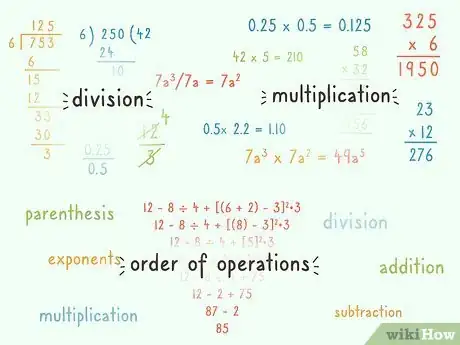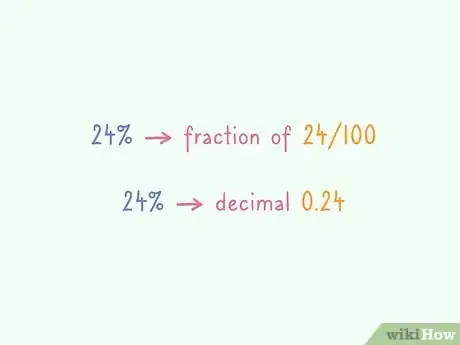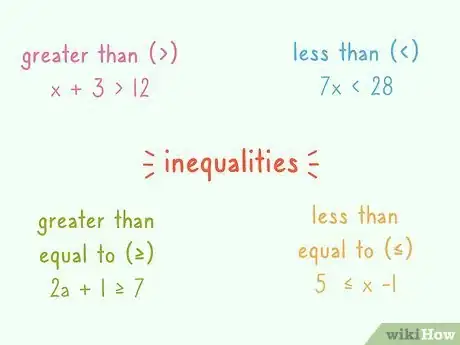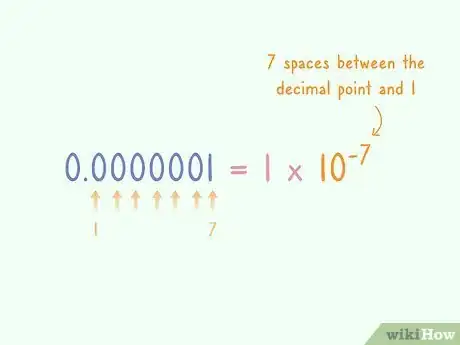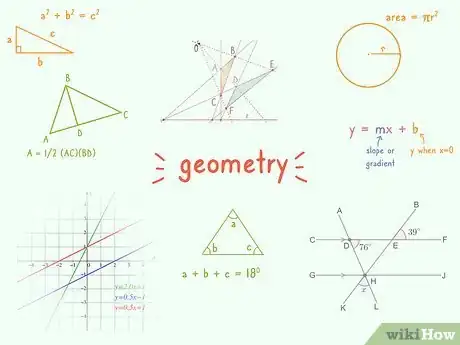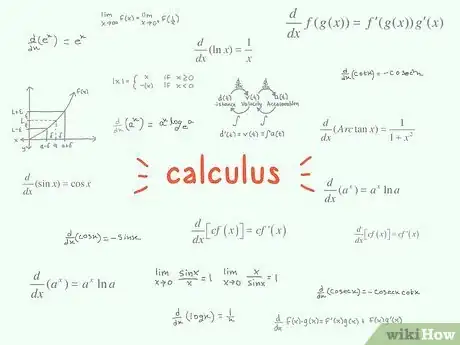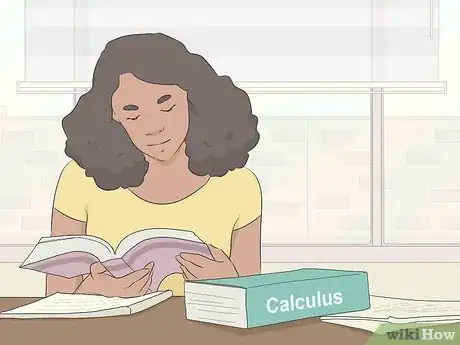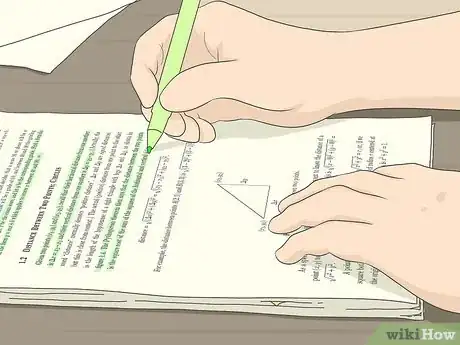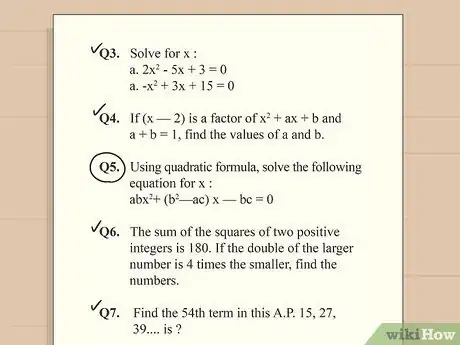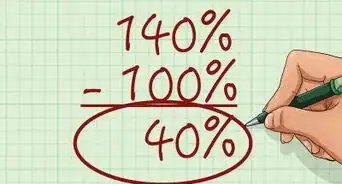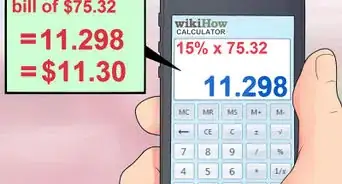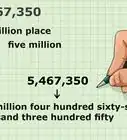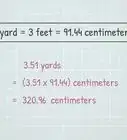This article was co-authored by Arash Fayz and by wikiHow staff writer, Hannah Madden. Arash Fayz is the Co-Founder and Executive Director of LA Tutors 123, an academic consulting and private tutoring company based in Los Angeles, California. Arash has over 10 years of educational consulting experience, managing the tutoring of students of all ages, abilities, and backgrounds to score higher on standardized tests and gain admission to their target schools. He has a BA in Applied Mathematics and Computer Science from the University of California, Los Angeles.
There are 11 references cited in this article, which can be found at the bottom of the page.
This article has been viewed 24,023 times.
While you can't pass or fail a placement test, your score will determine which mathematics class you should be placed in based on your knowledge and skills. Before you take the test, review basic math concepts, geometry, algebra, and calculus. Take your time during the test and remember that it's meant to determine which concepts you're proficient at and which you may need to spend some more time learning about. Don't worry too much about your score—being placed in the right class will ensure you're not struggling with concepts that are too difficult for your current skillset.
Steps
Reviewing Basic Math
-
1Review division, multiplication, and the order of operations. Basic math concepts are still fair game on a math placement test. Go over long division, multiplication, and how to follow the order of operations. Make sure you know how to apply those to different math concepts and can do them long form as well as with a calculator.[1]
- You will most likely be allowed to use a calculator on a math placement test, but some problems might ask you to show your work.
-
2Go over conversions between fractions and decimals. Fractions and decimals can describe the same number, but they display it in a different way. Make sure you know how to convert from fractions to decimals and vice versa. Look out for fractions that are written as percentages.[2]
- For example, 24% indicates a fraction of 24/100.
- You may be asked to convert 24% to a decimal. Divide 24/100 to get 0.24.
Advertisement -
3Make sure you know how to work with inequalities. Most often, these problems are given as 2 numbers and you are asked to put a “<” “>” or “=” in between them to signify if they are less than, greater than, or equal to each other.[3]
- For example, a problem might read -3 __ 6
- Add a “<” to read -3 < 6
-
4Look over scientific notation rules. Scientific notation is the standard for which long numbers, either whole or decimal, are written. Significant digits are the numbers that are significant. These usually exclude 0s.[4]
- For example, when writing 0.0000001, you would instead notate 1 x 10^-7. This signifies that to get the decimal number, you have to move the decimal point 7 times to the left.
Looking Over Complex Concepts
-
1Reexamine intermediate algebra.[5] Most of intermediate algebra consists of solving equations that have letters substituted for numbers. Brush up on how you would solve for “x” in any given equation. Be prepared to solve for multiple letters in 1 problem.[6] Some examples of intermediate algebra are:
- Factoring polynomials, setting up equations, linear equations, exponents and radicals, simplifying radical expressions, and the AC method of factoring.[7]
-
2Go over geometry concepts. Geometry is a large field of study, and there will most likely be a dedicated section to it on your placement test. Review concepts that you learned from high school and be prepared to use your graphing calculator to assist you.[8] Some concepts from the geometry portion of the test include:
- Nonlinear points, intersecting lines, perpendicular lines, angle measurements, and line distance measurements.[9]
-
3Prepare for the calculus portion of the test. Calculus includes graphing, functions, and trigonometry. Review these concepts and prepare to use the graphing function on your calculator to solve these problems.[10] Some examples of the calculus portion of the test include:
- Functions, exponents and radicals, complex numbers, matrices, and factorials.[11]
Studying Effectively
-
1Look over as many topics as you can before the test. Most math placement tests will give you credit for proving that you understand most of each topic. Study a wide range of what you have learned in the past: algebra, statistics, geometry, and calculus are all fair game when it comes to a math placement test.[12]
Tip: This is especially true for the ALEKS math placement test, which is the one most commonly used for colleges.
-
2Go over the concepts before you try any practice questions. You will have a much easier time studying for your placement test if you review the math concepts you have learned throughout your school years.[13] Take a look at math that you learned at the beginning of high school all the way up to the highest level that you have learned. Look through your old notes or find example questions online of basic algebra, fractions, and even word problems.[14]
-
3Avoid trying to learn concepts you aren’t familiar with. Everyone’s math level is different. If you didn’t quite make it to calculus in high school or you are still stuck on algebra, that’s okay! Don’t try to teach yourself new concepts. Instead, review the ones that you are knowledgeable in so that you do well on those sections of the test. Focus on reexamining rather than learning.[15]
- You can’t fail a math placement test. Just do the best that you can on the levels that you do know.
-
4Take practice tests and answer practice problems online. The best way to prepare for a placement test is to answer questions that are similar to the ones on the real test.[16] Check to see if your college website has a practice test that you can print out and answer. Or, search online for a practice math placement test. Make sure it has a variety of concepts so that you can use all of your knowledge and skills.[17]
- If you can find out which specific placement test you will be taking, search practice tests for that specific test. Otherwise, just search for general math placement test questions.
Taking the Placement Test
-
1Take your time when working through the problems. Don’t rush through your placement test, even if you think you are an expert. Work slowly through the problems and make sure to read each one carefully. Double check your work if you have time to make sure you are answering correctly.[18]
- Some math placement tests are timed, but others are not. If yours is timed, do the questions that take you the least time first and then move onto harder ones.
-
2Complete the sample questions if your test gives them to you. Some standardized placement tests, like Accuplacer, give you 1 to 2 sample questions to prepare you for the section you are about to take. Use these questions as an example of what is to come and prepare yourself for questions that are similar.[19]
- Use these questions to think back on what you have reviewed and go over the general rules in your head.
-
3Skip the questions you don’t know and come back to them. If you get stuck on a question, leave it until the very end and focus on the problems that you do know how to answer. Be sure to mark your page or remember to come back to it somehow so you don’t leave it blank. Leave yourself enough time at the end of the test to complete the problems you were unsure about.[20]
-
4Review your answers before you turn in your test. Sometimes the stress of doing well on a test can make you make simple mistakes. If you have time, go over your answers right before you turn in your test. Double-check your work with a calculator to make sure you didn’t accidentally subtract when you meant to add, or multiply instead of divide.[21]
Tip: If you don’t have time to go over all of your answers, that’s okay. Check the ones that you had the most trouble with to make sure you did them right.
-
5Try not to be disappointed if you place into a lower-level math class. A placement test is a way to gauge what level of math you are proficient in and what you need to learn still. Don’t be discouraged if you get your results back and they are lower than you expected. All that means is you might need a few more classes to boost your math skills.[22]
- Some colleges will not give you credit for your math class until you reach a certain level. Check with your course advisor to see how many math classes you need to take for your particular department or degree.
- Often, your score on each section of the test correlates to what math class you are placed into. If you did great on the geometry section but poorly on the calculus one, you will likely be placed into a lower-level calculus class.
- The level of math that you need to take in college varies based on your major. An English major might not need to take as many math classes as a chemistry student would. Check with your advisor if you are confused about how many credits you need.
Expert Q&A
Did you know you can get expert answers for this article?
Unlock expert answers by supporting wikiHow
-
QuestionHow do I study for a college placement test?
 Arash FayzArash Fayz is the Co-Founder and Executive Director of LA Tutors 123, an academic consulting and private tutoring company based in Los Angeles, California. Arash has over 10 years of educational consulting experience, managing the tutoring of students of all ages, abilities, and backgrounds to score higher on standardized tests and gain admission to their target schools. He has a BA in Applied Mathematics and Computer Science from the University of California, Los Angeles.
Arash FayzArash Fayz is the Co-Founder and Executive Director of LA Tutors 123, an academic consulting and private tutoring company based in Los Angeles, California. Arash has over 10 years of educational consulting experience, managing the tutoring of students of all ages, abilities, and backgrounds to score higher on standardized tests and gain admission to their target schools. He has a BA in Applied Mathematics and Computer Science from the University of California, Los Angeles.
Test Prep Tutor
-
QuestionWhat kind of math is on a placement test?
 Arash FayzArash Fayz is the Co-Founder and Executive Director of LA Tutors 123, an academic consulting and private tutoring company based in Los Angeles, California. Arash has over 10 years of educational consulting experience, managing the tutoring of students of all ages, abilities, and backgrounds to score higher on standardized tests and gain admission to their target schools. He has a BA in Applied Mathematics and Computer Science from the University of California, Los Angeles.
Arash FayzArash Fayz is the Co-Founder and Executive Director of LA Tutors 123, an academic consulting and private tutoring company based in Los Angeles, California. Arash has over 10 years of educational consulting experience, managing the tutoring of students of all ages, abilities, and backgrounds to score higher on standardized tests and gain admission to their target schools. He has a BA in Applied Mathematics and Computer Science from the University of California, Los Angeles.
Test Prep Tutor
References
- ↑ http://www.hunter.cuny.edu/testingcenter/mathematics-placement-exam-1
- ↑ https://www.purplemath.com/modules/percents.htm
- ↑ https://www.purplemath.com/modules/negative.htm
- ↑ http://www.hunter.cuny.edu/testingcenter/mathematics-placement-exam-1
- ↑ Arash Fayz. Test Prep Tutor. Expert Interview. 1 November 2019.
- ↑ http://www.hunter.cuny.edu/testingcenter/mathematics-placement-exam-1
- ↑ https://www.mesacc.edu/testing-services/study-guides-placement-tests/math-study-guide
- ↑ https://www.mesacc.edu/testing-services/study-guides-placement-tests/math-study-guide
- ↑ https://www.mesacc.edu/testing-services/study-guides-placement-tests/math-study-guide
- ↑ http://www.hunter.cuny.edu/testingcenter/mathematics-placement-exam-1
- ↑ https://www.mesacc.edu/testing-services/study-guides-placement-tests/math-study-guide
- ↑ https://www.youtube.com/watch?v=_BbXfSOQt-4&feature=youtu.be&t=136
- ↑ Arash Fayz. Test Prep Tutor. Expert Interview. 1 November 2019.
- ↑ https://www.youtube.com/watch?v=_BbXfSOQt-4&feature=youtu.be&t=244
- ↑ https://www.mesacc.edu/testing-services/study-guides-placement-tests/math-study-guide
- ↑ Arash Fayz. Test Prep Tutor. Expert Interview. 1 November 2019.
- ↑ https://www.barton.edu/pdf/math/practice-math-placement-test.pdf
- ↑ https://spscc.instructure.com/courses/1345787/pages/general-testing-tips
- ↑ https://spscc.instructure.com/courses/1345787/pages/general-testing-tips
- ↑ https://www-math.umd.edu/cgi-bin/placement/index.cgi
- ↑ https://sciencing.com/how-to-prepare-for-a-math-placement-test-12745921.html
- ↑ https://sciencing.com/how-to-prepare-for-a-math-placement-test-12745921.html
